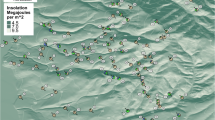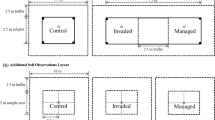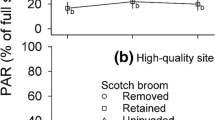Abstract
Ecological conditions following removal of exotic plants are a key part of comprehensive environmental management strategies to combat exotic plant invasions. We examined ecological conditions following removal of the management-priority buffelgrass (Pennisetum ciliare) in Saguaro National Park of the North American Sonoran Desert. We assessed soil, vegetation, and soil seed banks on seven buffelgrass site types: five different frequencies of buffelgrass herbicide plus hand removal treatments (ranging from 5 years of annual treatment to a single year of treatment), untreated sites, and non-invaded sites, with three replicates for each of the seven site types. The 22 measured soil properties (e.g., pH) differed little among sites. Regarding vegetation, buffelgrass cover was low (≤1 % median cover), or absent, across all treated sites but was high (10–70 %) in untreated sites. Native vegetation cover, diversity, and composition were indistinguishable across site types. Species composition was dominated by native species (>93 % relative cover) across all sites except untreated buffelgrass sites. Most (38 species, 93 %) of the 41 species detected in soil seed banks were native, and native seed density did not differ significantly across sites. Results suggest that: (1) buffelgrass cover was minimal across treated sites; (2) aside from high buffelgrass cover in untreated sites, ecological conditions were largely indistinguishable across sites; (3) soil seed banks harbored ≥12 species that were frequent in the aboveground vegetation; and (4) native species dominated post-treatment vegetation composition, and removing buffelgrass did not result in replacement by other exotic species.





Similar content being viewed by others
References
Abella SR (2010) Disturbance and plant succession in the Mojave and Sonoran Deserts of the American Southwest. Intern J Environ Res Public Health 7:1248–1284
Abella SR, Chiquoine LP, Backer DM (2012) Ecological characteristics of sites invaded by buffelgrass (Pennisetum ciliare). Invasive Plant Sci Manag 5:443–453
Allen JA, Brown CS, Stohlgren TJ (2009) Non-native plant invasions of United States national parks. Biol Invasions 11:2195–2207
Bakker JP, Poschlod P, Strykstra RJ, Bekker RM, Thompson K (1996) Seed banks and seed dispersal: important topics in restoration ecology. Acta Bot Neerl 45:461–490
Bowers JE, McLaughlin SP (1987) Flora and vegetation of the Rincon Mountains, Pima County, Arizona. Desert Plants 8:51–94
Butterfield BJ, Betancourt JL, Turner RM, Briggs JM (2010) Facilitation drives 65 years of vegetation change in the Sonoran Desert. Ecology 91:1132–1139
Clarke PJ, Latz PK, Albrecht DE (2005) Long-term changes in semi-arid vegetation: invasion of a non-native perennial grass has larger effects than rainfall variability. J Veg Sci 16:237–248
Cochran CC, Richardson ML (2003) Soil survey of Pima County, Arizona, eastern part. U.S. Department of Agriculture, Natural Resources Conservation Service. U.S. Gov Print Office, Washington, DC
Corbin JD, D’Antonio CM (2012) Gone but not forgotten? Invasive plants’ legacies on community and ecosystem properties. Invasive Plant Sci Manage 5:117–124
Daehler CC, Goergen EM (2005) Experimental restoration of an indigenous Hawaiian grassland after invasion by buffel grass (Cenchrus ciliaris). Restor Ecol 13:380–389
Dixon IR, Dixon KW, Barrett M (2002) Eradication of buffel grass (Cenchrus ciliaris) on Airlie Island, Pilbara Coast, western Australia. In: Veitch CR, Clout MN (eds) Turning the tide: eradication of invasive species. International Union for the Conservation of Nature SSC Invasive Species Specialist Group, Gland, Cambridge, pp 92–101
Ehrenfeld JG (2003) Effects of exotic plant invasions on soil nutrient cycling processes. Ecosystems 6:503–523
Esque TC, Schwalbe CR, Lissow JA, Haynes DF, Foster D, Garnett MC (2007) Buffelgrass fuel loads in Saguaro National Park increase fire danger and threaten native species. Park Sci 24:33–37
Flory SL, Clay K (2009) Invasive plant removal method determines native plant community responses. J Appl Ecol 46:434–442
Guo Q, Rundel PW, Goodall DW (1998) Horizontal and vertical distribution of desert seed banks: patterns, causes, and implications. J Arid Environ 38:465–478
Harms RS, Hiebert RD (2006) Vegetation response following invasive tamarisk (Tamarix spp.) removal and implications for riparian restoration. Restor Ecol 14:461–472
Hejda M, Pyšek P, Jarošik V (2009) Impact of invasive plants on the species richness, diversity and composition of invaded communities. J Ecol 97:393–403
Hussain F, Ahmad B, Ilahi I (2010) Allelopathic effects of Cenchrus ciliaris L. and Bothriochloa pertusa (L.) A. Camus. Pak J Bot 42:3587–3604
Jordan NR, Larson DL, Huerd SC (2011) Evidence of qualitative differences between soil-occupancy effects of invasive vs. native grassland plant species. Invasive Plant Sci Manage 4:11–21
Levine JM, Vila M, D’Antonio CM, Dukes JS, Grigulis K, Lavorel S (2003) Mechanisms underlying the impacts of exotic plant invasions. Proc Royal Soc London B 270:775–781
Lyons KG, Maldonado-Leal BG, Owen G (2013) Community and ecosystem effects of buffelgrass (Pennisetum ciliare) and nitrogen deposition in the Sonoran Desert. Invasive Plant Sci Manage 6:65–78
Marshall VM, Lewis MM, Ostendorf B (2012) Buffel grass (Cenchrus ciliaris) as an invader and threat to biodiversity in arid environments: a review. J Arid Environ 78:1–12
McCune B, Mefford MJ (1999) PC-ORD: multivariate analysis of ecological data. Vers 4. User’s guide. MjM Software Design, Gleneden Beach, Oregon, USA
McDonald CJ, McPherson GR (2011) Fire behavior characteristics of buffelgrass-fueled fires and native plant community composition in invaded patches. J Arid Environ 75:1147–1154
McIvor J (2003) Competition affects survival and growth of buffelgrass seedlings—is buffelgrass a colonizer or invader? Trop Grasslands 37:176–178
NRCS [Natural Resources Conservation Service] (2012) The PLANTS database. National Plant Data Center, Baton Rouge, Louisiana, USA. http://plants.usda.gov. Accessed 15 Aug 2012
Olsson AD, Betancourt JL, Crimmins MA, Marsh SE (2012a) Constancy of local spread rates for buffelgrass (Pennisetum ciliare L.) in the Arizona Upland of the Sonoran Desert. J Arid Environ 87:136–143
Olsson AD, Betancourt J, McClaran MP, Marsh SE (2012b) Sonoran Desert ecosystem transformation by a C4 grass without the grass/fire cycle. Div Distrib 18:10–21
Owen SM, Sieg CH, Gehring CA (2011) Rehabilitating downy brome (Bromus tectorum)-invaded shrublands using imazapic and seeding with native shrubs. Invasive Plant Sci Manage 4:223–233
Parker SS, Schmel JP (2010) Invasive grasses increase nitrogen availability in California grassland soils. Invasive Plant Sci Manage 3:40–47
Peet RK, Wentworth TR, White PS (1998) A flexible, multipurpose method for recording vegetation composition and structure. Castanea 63:262–274
Ransom CV, Christensen SD, Edvarchuk KA, Naumann T (2012) A reinventory of invasive weed species in Dinosaur National Monument to determine management effectiveness. Invasive Plant Sci Manage 5:300–309
Reynolds LV, Cooper DJ (2011) Ecosystem response to removal of exotic riparian shrubs and a transition to upland vegetation. Plant Ecol 212:1243–1261
Rutman S, Dickson L (2002) Management of buffelgrass on organ pipe cactus national monument, Arizona. In: Tellman B (ed) Invasive exotic species in the Sonoran region. The University of Arizona Press and The Arizona-Sonora Desert Museum, Tucson, pp 311–318
SAS Institute (2009) SAS/STAT 9.2 user’s guide. SAS Institute, Cary, North Carolina, USA
Schneider HE, Allen EB (2012) Effects of elevated nitrogen and exotic plant invasion on soil seed bank composition in Joshua Tree National Park. Plant Ecol 213:1277–1287
Sheley RL, Denny MK (2006) Community response of nontarget species to herbicide application and removal of the nonindigenous invader Potentilla recta L. West North Amer Nat 66:55–63
Simberloff D, Martin J, Genovesi P, Maris V, Wardle DA, Aronson J, Courchamp F, Galil B, García-Berthou E, Pascal M, Pyšek P, Sousa R, Tabacchi E, Vilà M (2013) Impacts of biological invasions: what’s what and the way forward. Trends Ecol Evol 28:58–66
Stevens J, Falk DA (2009) Can buffelgrass invasions be controlled in the American Southwest? Using invasion ecology theory to understand buffelgrass success and develop comprehensive restoration and management. Ecol Restor 27:417–427
Throop HL, Archer SR, Monger HC, Waltman S (2012) When bulk density methods matter: implications for estimating soil organic carbon pools in rocky soils. J Arid Environ 77:66–71
Tjelmeland AD, Fulbright TE, Lloyd-Reilley J (2008) Evaluation of herbicides for restoring native grasses in buffelgrass-dominated grasslands. Restor Ecol 16:263–269
Vidra RL, Shear TH, Stucky JM (2007) Effects of vegetation removal on native understory recovery in an exotic-rich urban forest. J Torrey Bot Soc 134:410–419
Ward JP, Smith SE, McClaran MP (2006) Water requirements for emergence of buffelgrass (Pennisetum ciliare). Weed Sci 54:720–725
Wolfe BE, Klironomos JN (2005) Breaking new ground: soil communities and exotic plant invasion. Bioscience 55:477–487
Woods SR, Fehmi JS, Backer DM (2012) An assessment of revegetation treatments following removal of invasive Pennisetum ciliare (buffelgrass). J Arid Environ 87:168–175
Zavaleta ES, Hobbs RJ, Mooney HA (2001) Viewing invasive species removal in a whole-ecosystem context. Trends Ecol Evol 16:454–459
Acknowledgments
This study was funded by the Natural Resource Preservation Program of the National Park Service through a cooperative agreement between the National Park Service (Saguaro National Park [SNP]) and the University of Nevada Las Vegas (UNLV). We thank Joslyn Curtis (UNLV) for collecting plant community data; Sharon Altman (UNLV) for preparing the figures; and Perry Grissom (SNP), Peter Budde, three anonymous reviewers, and the editorial board for providing helpful comments on the manuscript. Any use of trade names is for descriptive purposes only and does not imply endorsement by the U.S. Government.
Author information
Authors and Affiliations
Corresponding author
Electronic supplementary material
Below is the link to the electronic supplementary material.
Rights and permissions
About this article
Cite this article
Abella, S.R., Chiquoine, L.P. & Backer, D.M. Soil,Vegetation, and Seed Bank of a Sonoran Desert Ecosystem Along an Exotic Plant (Pennisetum ciliare) Treatment Gradient. Environmental Management 52, 946–957 (2013). https://doi.org/10.1007/s00267-013-0104-y
Received:
Accepted:
Published:
Issue Date:
DOI: https://doi.org/10.1007/s00267-013-0104-y




